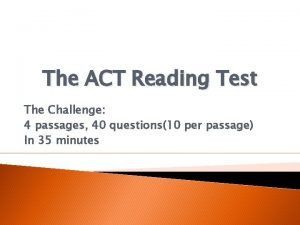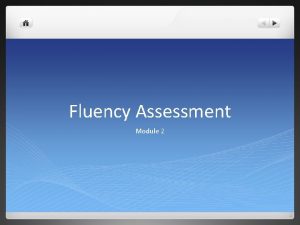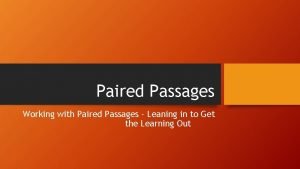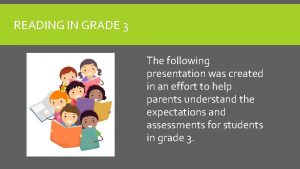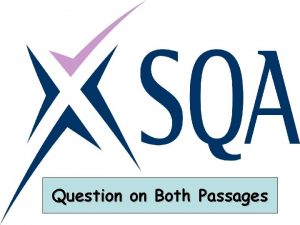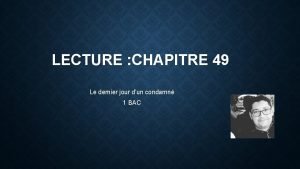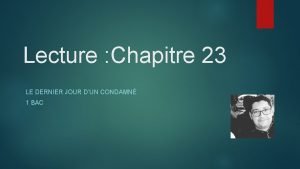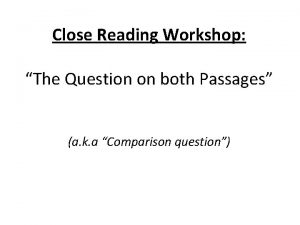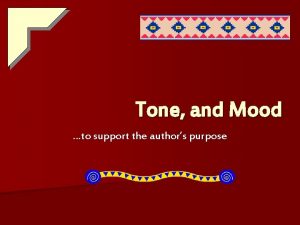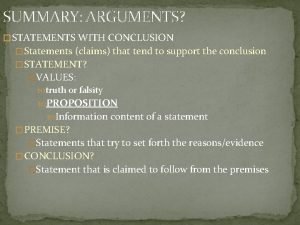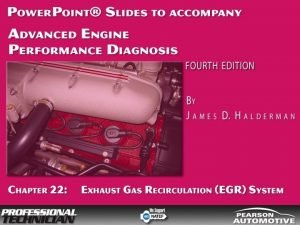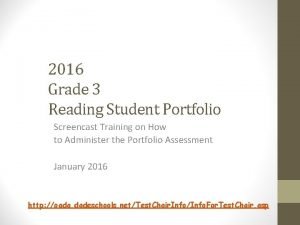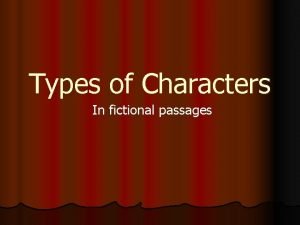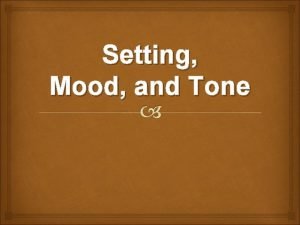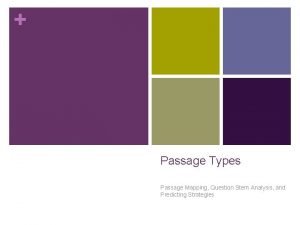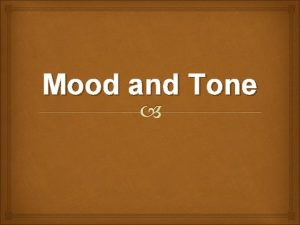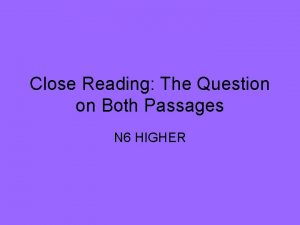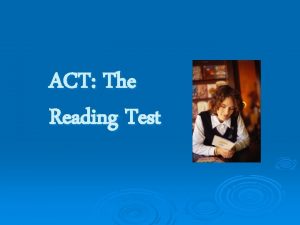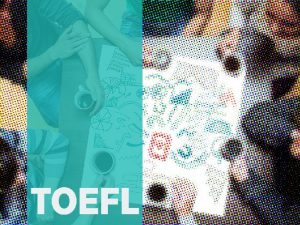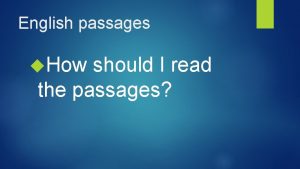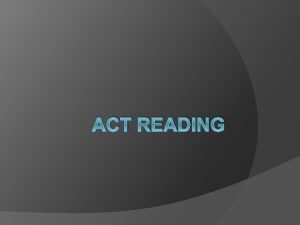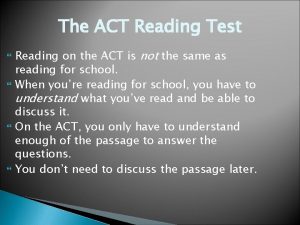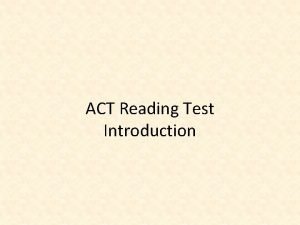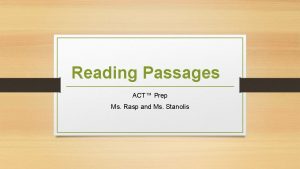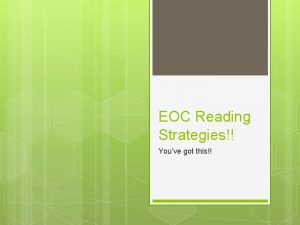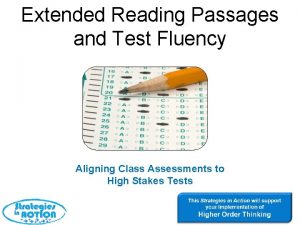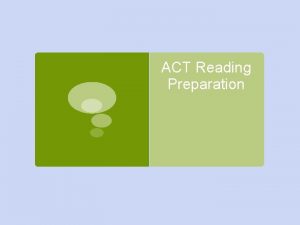The ACT Reading Test The Challenge 4 passages





















- Slides: 21

The ACT Reading Test The Challenge: 4 passages, 40 questions(10 per passage) In 35 minutes

ACT says the passages are “typical of what a college freshman might be required to read…” ACT says the questions are to test your ability to “understand” the passage. � REALITY CHECK! Understanding may not be possible by simply reading a fragment. And college professors will never ask you to read a passage in 8 -9 min, think it through and understand it. � SO, in REALITY you are reading to find the right answers.

Get WISE to the test & approach it with some strategy. ∙Attack passages in the order that suits you. ∙ See through the camouflage that hides correct answers ∙ Get wise to distracters & use Process of Elimination (POE) ∙ Answer questions without really reading the passage

Strategy #1 ORDERING THE PASSAGES Four passages from these fields of study: 1 - prose fiction (short story or novel) 2 - social studies (history, econ. , psych. , pol. sci. , anthropology) 3 - humanities (art, music, architecture, dance) 4 - natural science (biology, chemistry, physics, phys. science) The passages are always in the same order. Choose the passage from the field you will handle best, FIRST!

A few points about the passages… Prose fiction - asks you to “read between the lines” and recognize characterization and what motivates characters Social Studies & Humanities - an author’s view is given and you are asked to draw inferences about it Natural Science – the passages are filled with detail and technical descriptions. The questions follow the text closely with few inferences.

Which passages are “user-friendly? ” ▶Recognize your strengths when scanning the passages. For example you notice the social studies passage is written chronologically, which you find easier to read. Read it first. ▶ If a passage is on a topic you recently studied and you’re feeling confident. Go for it first! ▶ Check out the questions and answers. If they appear to be miniature novels, they may take some time. If straightforward, referring to particular line numbers, italicized words, dates, etc. they may take less time to answer. REMEMBER – You don’t have to understand the passage, you have to find the right answer!!!!

Strategy #2 SEE THROUGH THE CAMOUFLAGE Look at these two phrases: “rationally conceived idea” “concept born of reason” There’s not a single word in common but they essentially mean the same thing. One is a paraphrase of the other. ACT does this with many reading questions. *Refer to worksheet. “See Through the Camouflage” Do Example #1 & #2

Strategy #3 –RECOGNIZE DISTRACTORS and use POE Standard test makers purposefully design answers that misdirect your thinking by breaking your concentration, distracting you, and throwing you off course. 4 kinds of distracters 1) Deceptive Answers 2) Switches 3) Extremes 4) “Nice” Choices

Distracter 1 – Deceptive Answers This type distracter steals words from the passage and includes them in the answer, but does not reflect the content of the passage. Simple example: � Tom loves going to the movies with Mary. What’s the writer’s meaning? � Tom fell in love with Mary at the movies � Tom and Mary love the movies � Tom and Mary generally enjoy seeing movies about love. Each statement distorts the original by taking words and rearranging them. - *See Worksheet page 2 - “Get Wise to Distracters Deceptive Answers Example 1 & 2

Distracter 2 – Switches Consider these sentences: Professor Thorne generally explains a technological discovery first in terms of its history and then in terms of the science upon which it was founded. Professor Thorne generally explains a technological discovery first in terms of science on which it was founded and then in terms of its history. This is an obvious switch. The order in which the Professor presents new material is reversed. ACT will do this - change the wording and flip the meaning. .

Switches cont’d A possible time saver. Sometimes switches give you a shortcut. If the answer choices feature two 2 opposite statements, you might be able to focus on those 2 and ignore the other two choices. � For instance if you have these answer choices: A) important in that it shows certain propositions to be true. B) important in that it shows certain propositions to be false. C) less precise than most scientists believe. D) extremely misleading to those who fail to question its premises. � Since the first two are opposites…you could focus on selecting A or B and ignore C and D. *WORKSHEET, page 3 - Switches

Distracter 3 – Extremes Be alert to answers that include words like: always , invariably , or never. They are usually wrong. These signal an extreme choice. Extremes tend to be wrong because they are debatable. Other words that indicate extremes: completely, perfectly, absolutely, all. And beware of phrases like “cannot possibly, ” “completely objective, ” and “hopelessly confused. ” Example: A political leader should seek to make peace at all costs. All costs? No matter what? Standardized test writers find these extremes useful when constructing their answers and use them often. Now you know.

Distracter 4 – Choices that Sound too “Nice” Some answers sound “nice, ” but have little to do with the passage. Such distracters draw on something you know, or on the surface they are a reasonable statement, something that appears to be beyond challenge. For example: The ideal society is one that allows for individual difference, but at the same time creates a people united in interest. When drawn to such an answer choice (and it may be correct!) check the questions and ask yourself if it’s just a sweet and easy sentiment or whether it REALLY answers the question. *Worksheet page 4 Extremes and “Too Nice”

Strategy #4 Answer the questions without really reading Step 1: 2: 3: 4: Find the Lead Words and Phrases Scan the Passage for Lead Words Skim and Scribble Answer the questions

Why is the reading so difficult? ACT is asking you to read a passage, out of context, and you don’t know what you’re look for! Here’s a method that may help…in 4 steps. � Steps 1 & 2 help you avoid wasting time trying to read and comprehend the whole passage. And you will identify places in the passage likely to provide answers. � Step 1 & 2 should take 60 seconds per passage.

Step 1: Find the Lead Words and Phrases in the QUESTIONS Before reading the passage look at the questions (not the answers) and underline lead words. Lead words are words, phrases or names that stand out and tell what the question’s about. Example - Underline lead words: The author states that the common law differs from the civil law in that: (Don’t worry about the meaning of unfamiliar words. Just find the focus of the questions. ) You will notice some questions don’t have lead words. For example: Which of the following conclusions is drawn by the passage? OR It can be most reasonably inferred that the author believes that: Lead words are unique to the question. Among the 10 questions you will answer for a passage you will find 8 -9 containing lead words.

Step 2: Scan the PASSAGE for same Lead Words Now look at the passage. Scan quickly (don’t read it!) and look for lead words you have already identified. Pass your eyes over it and underline lead words. This should take 30 sec. As you read the questions you are able to go from the question directly to the underlined lead word in the passage to determine the answer. Beware! You don’t always find the answer in a single sentence. You may have to read around the underlined word to make your selection.

Step 3: Skim and Scribble This step should take no more than 60 sec. Skim the entire passage. In the margin write a word or two describing the main idea of each paragraph. Direct most of your attention to the first 2 sentences of the paragraph. Watch for trigger words like nonetheless, on the other hand, unfortunately signaling the author is “going somewhere. ” It might mean a conclusion is being made.

Step 4: Answer the QUESTIONS With Steps 1, 2, & 3 complete it should take you approx. 40 sec. to answer each question! First select questions that point to the answer. These questions send you directly to critical words underlined. Also, these questions may direct you by specific line number.

Begin using what you’ve learned about distracters. -Does an answer strike you as correct, but seems “too nice” or “too easy”? -Is there a switch? -Do any of the answers contain extreme words? -Is there deceptive paraphrasing in the answer? Take a couple of passes at a question. Eliminate answers. Then make your choice. What if you can’t settle on an answer? GUESS. Chances are you are able to eliminate 1 -2 answers so you have increased your chances of choosing the correct answer.

RECAP of Steps 1 2 3 4 - Find Critical Words (30 sec) Scan the passage for Critical Words (30 sec) Skim and Scribble (60 sec) Answer the questions (40 sec per question) Each passage = 8 min. 40 sec. REALLY? ? ? Let’s Try It…….
 Act reading passages
Act reading passages Cbm reading fluency passages
Cbm reading fluency passages Spotlight on paired passages
Spotlight on paired passages While reading activities
While reading activities Whitchester house
Whitchester house Act 1 act 2 act 3
Act 1 act 2 act 3 West java leaders reading challenge
West java leaders reading challenge Released rta passages
Released rta passages Reading scanning
Reading scanning Which idea is presented in both passages
Which idea is presented in both passages Analyse du chapitre 49 le dernier jour d'un condamné
Analyse du chapitre 49 le dernier jour d'un condamné Situation du passage dernier jour d'un condamné
Situation du passage dernier jour d'un condamné Both passages
Both passages Tone and mood paragraph examples
Tone and mood paragraph examples Inferential claim example
Inferential claim example Two technicians are discussing clogged egr passages
Two technicians are discussing clogged egr passages Portfolio grade 3
Portfolio grade 3 Types of character in a story
Types of character in a story Mood passages
Mood passages Passage mapping
Passage mapping Tone and mood passages
Tone and mood passages Identify a key term used in both passages
Identify a key term used in both passages
